Attached files
| file | filename |
|---|---|
| 8-K - FORM 8K - DYCOM INDUSTRIES INC | form8k.htm |
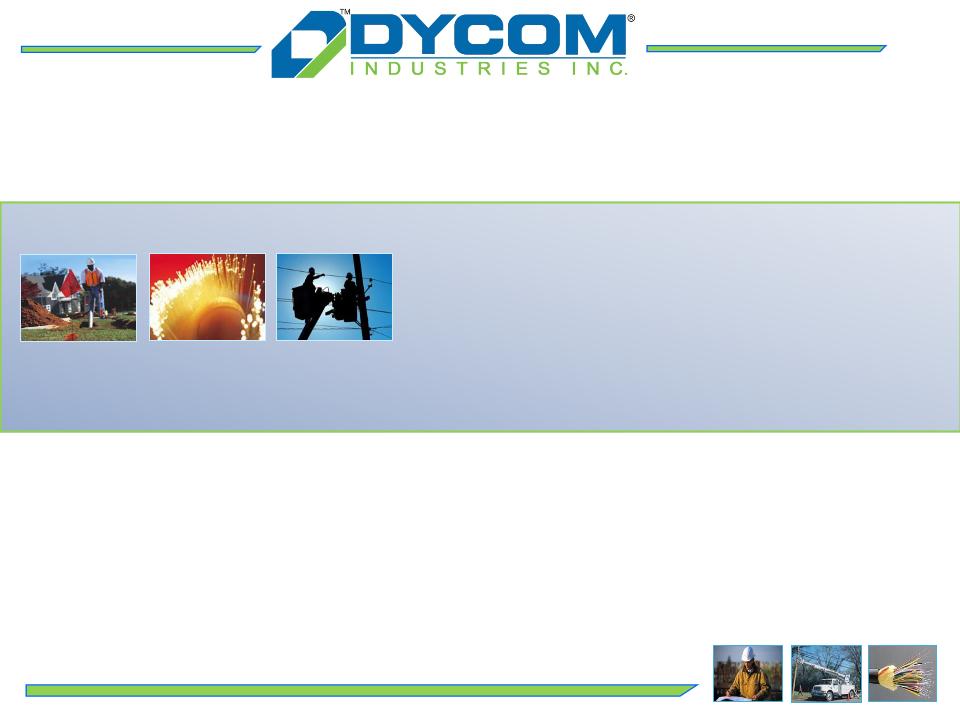
Credit
Suisse 2010 Engineering
and Construction Conference
June 3, 2010
and Construction Conference
June 3, 2010

2
Forward-Looking
Statements and Non-GAAP
Information
Information
Forward-Looking
Statements and Non-GAAP
Information
Information
This
presentation contains forward-looking statements within the meaning of the
Private
Securities Litigation Reform Act of 1995. The words “believe,” “expect,” “anticipate,”
“estimate,” “intend,” “forecast,” “may,” “should”, “could”, “project,” “outlook” and similar
expressions identify forward-looking statements. These forward-looking statements are
based on management’s current expectations, estimates and projections and speak only as
of the date of this presentation. Forward-looking statements are subject to known and
unknown risks and uncertainties that may cause actual results in the future to differ
materially from the results projected or implied in any forward-looking statements contained
in this presentation. The factors that could affect future results and could cause these results
to differ materially from those expressed in the forward-looking statements include, but are
not limited to, those described under Item 1A, “Risk Factors” of the Company’s Annual
Report on Form 10-K for the year ended July 25, 2009, and other risks outlined in the
Company’s periodic filings with the Securities and Exchange Commission (“SEC”). Except
as required by law, the Company may not update forward-looking statements even though
its situation may change in the future.
Securities Litigation Reform Act of 1995. The words “believe,” “expect,” “anticipate,”
“estimate,” “intend,” “forecast,” “may,” “should”, “could”, “project,” “outlook” and similar
expressions identify forward-looking statements. These forward-looking statements are
based on management’s current expectations, estimates and projections and speak only as
of the date of this presentation. Forward-looking statements are subject to known and
unknown risks and uncertainties that may cause actual results in the future to differ
materially from the results projected or implied in any forward-looking statements contained
in this presentation. The factors that could affect future results and could cause these results
to differ materially from those expressed in the forward-looking statements include, but are
not limited to, those described under Item 1A, “Risk Factors” of the Company’s Annual
Report on Form 10-K for the year ended July 25, 2009, and other risks outlined in the
Company’s periodic filings with the Securities and Exchange Commission (“SEC”). Except
as required by law, the Company may not update forward-looking statements even though
its situation may change in the future.
This
presentation includes certain “Non-GAAP” financial measures as defined by SEC
rules.
As required by the SEC we have provided a reconciliation of those measures to the most
directly comparable GAAP measures on the Regulation G slide included at the end of this
presentation.
As required by the SEC we have provided a reconciliation of those measures to the most
directly comparable GAAP measures on the Regulation G slide included at the end of this
presentation.

3
Dycom
Industries Introduction
n Leading provider of
specialty contracting services principally to
telephone and cable companies
telephone and cable companies
n Telecommunications
industry dynamics driving growth potential
n Major participant in
a large, but fragmented industry, which offers
acquisition opportunities
acquisition opportunities
n Significant portion
of revenues from multi-year Master Service
Agreements
Agreements
n Experienced
management team operating through a decentralized,
customer-focused organizational structure
customer-focused organizational structure
n Strong cash flows
and liquidity

4
Revenue
Mix
Quarter
Ended April 24, 2010- $231.6 million
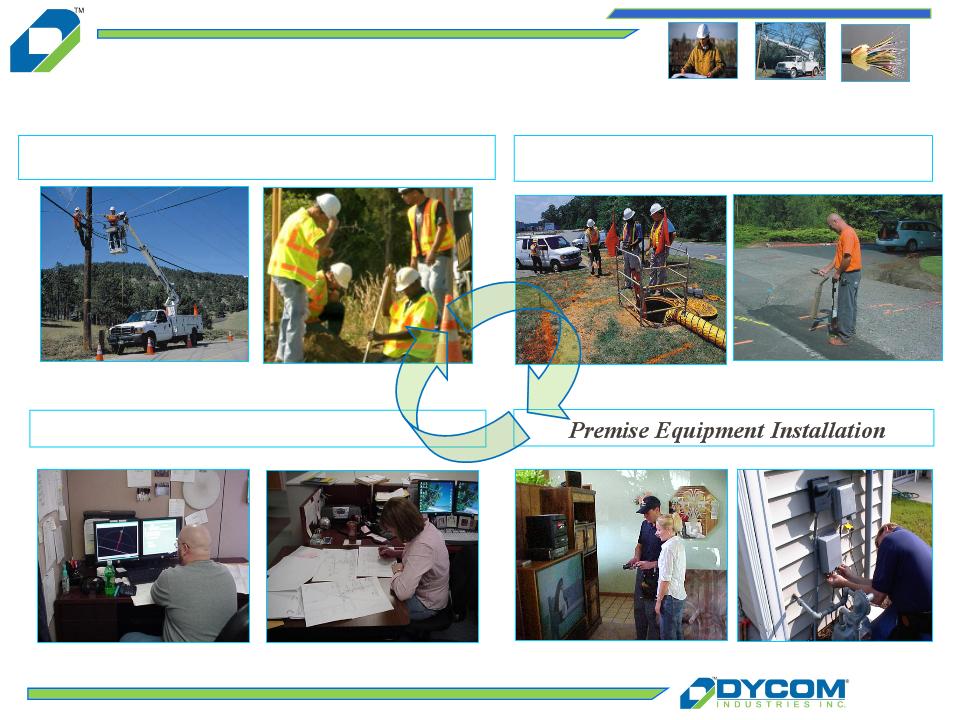
5
Providing
End-To-End Services
Engineering
Underground
Facility Locating
Outside
Plant & Equipment Installation
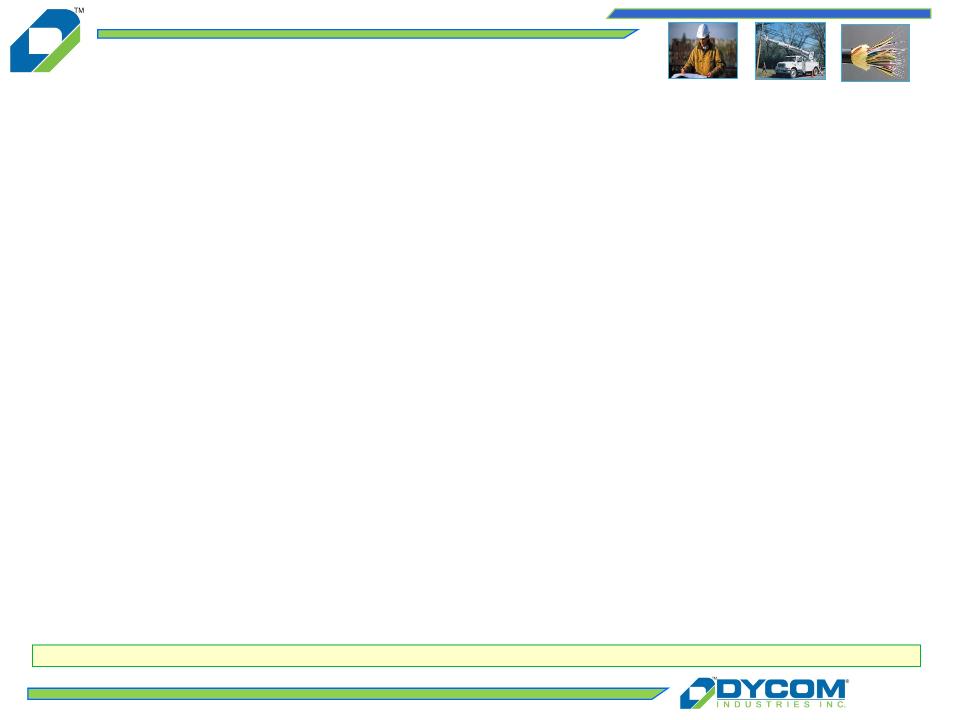
6
Dycom
Industries At a Glance
Dycom
is a leading telecommunications infrastructure provider in the United
States
n Headquartered in
Palm Beach Gardens, Florida
n Third quarter fiscal
2010 revenues of $231.6 million
n Strong financial
profile
} Cash and equivalents
$116.2 million at April 24, 2010
} Shareholders’ equity
$389.1 million at April 24, 2010
} Operating cash flow
of $126.6 million for fiscal year 2009
n Nationwide
footprint
} Operates in 48
states and to a limited extent in Canada
} 30 operating
subsidiaries and hundreds of field offices
n Over 8,500
employees
n Listed on the NYSE
under the ticker: DY
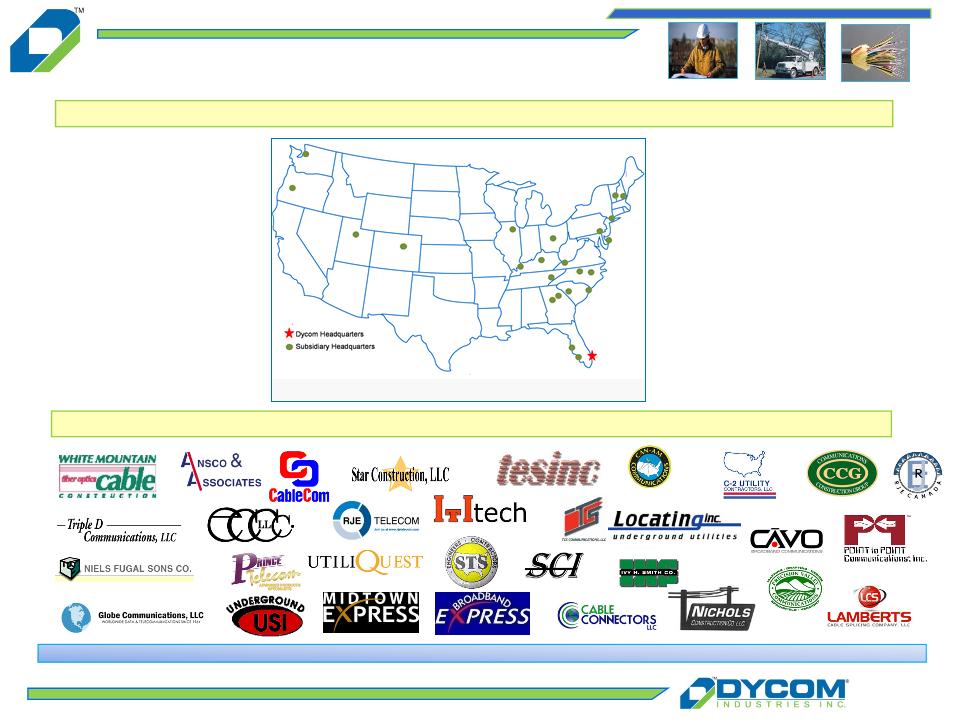
7
Strong
subsidiaries, broad national footprint
Subsidiaries
Dycom’s
Nationwide Presence
Dycom
Operating Overview

8
Industry
Developments…
n Telephone/cable
industry convergence - a reality
} Competition for
customers drives growth
n Network bandwidth
expansion - an imperative
} Telephone companies
expanding network capacity
} Cable responding to
match capabilities and facilitate new
products such as VOIP, HDTV, and wideband
products such as VOIP, HDTV, and wideband
n Product bundles -
key to telephone/cable success
} Decrease
churn
} Provide revenue
growth opportunities to offset market share
erosion
erosion
} Differentiate
service from satellite video providers

9
…And
Opportunities
n Increased capital
spending
} Telephone company
deployments of Fiber (FTTx)
} Cable company
bandwidth expansion
} Customer premise
equipment deployments
} Fiber to the cell
site
n Renewed focus on
network reliability and availability as subscribers
demand better service levels
demand better service levels
n Continued
outsourcing as time to market and installation quality
crucial for new product launches
crucial for new product launches
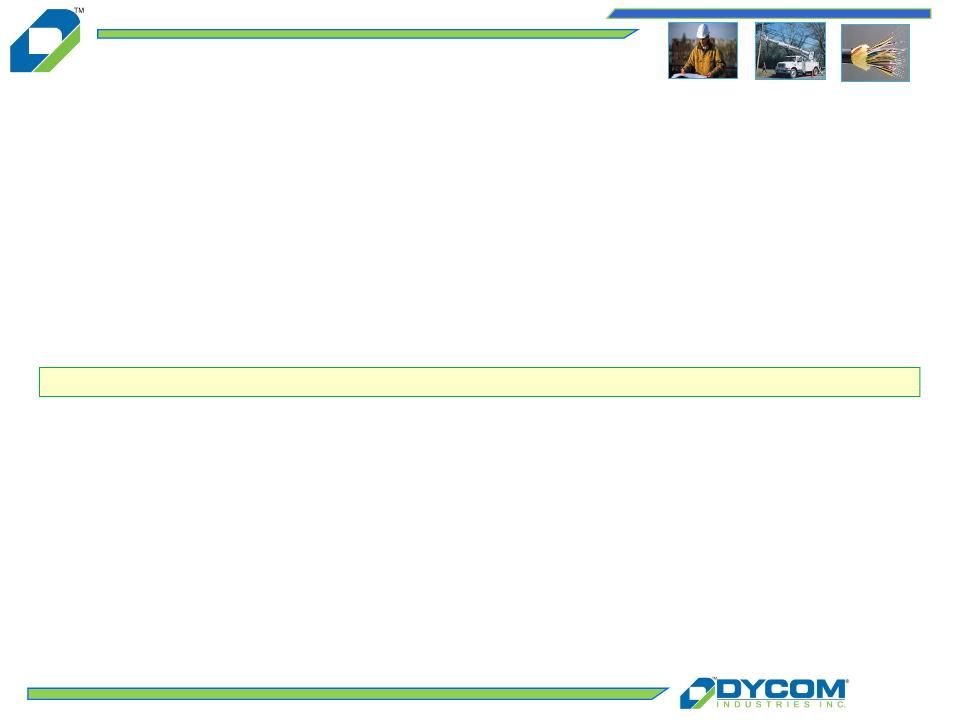
10
Telecom
Capital Spending
Capex
Commentary
n Continued capital
spending in wireline reflects burgeoning demand for voice, data and
video transmission
video transmission
n RBOCs will continue
to constitute the vast majority of U.S. fixed line investment
n Significant portion
of RBOCs’ capital budgets are expected to be from fiber deployments,
including fiber to the cell site initiatives
including fiber to the cell site initiatives
n Carriers are
shifting capital spending to address growth needs and increased
competition from cable companies
competition from cable companies
“…
we believe IPTV is an important part of our future. And
we’ll be looking for
ways to continue to expand our investment and the rollout of this product in the
months ahead.”
ways to continue to expand our investment and the rollout of this product in the
months ahead.”
Glen
Post III - CenturyLink
- Chairman and Chief Executive Officer May
2010

11
Cable
Capital Spending
Capex
Commentary
n Continued capital
expenditures on bandwidth reclamation, VOIP and HDTV product
offerings, and cellular backhaul
offerings, and cellular backhaul
n Ongoing plant and
network enhancements are critical as cable operators continue to
offer services that require greater reliability
offer services that require greater reliability
n Network capacity and
reliability increasingly crucial as cable companies compete with
traditional telecom firms
traditional telecom firms
“We
also continue to make significant progress deploying All-Digital and
DOCSIS
3.0. We reach nearly 80% of our footprint with DOCSIS 3.0, reinforcing our
leadership position in broadband. As we deploy this capability, we are doubling the
speeds to our existing customers and introducing new, higher-speed services in
these markets. Today, we offer 50 Mb speed service to 40 million homes where it is
available and will soon begin to roll out 100 Mb service. We are now actively
deploying All-Digital in many of our markets, recapturing and more efficiently using
our bandwidth.”
3.0. We reach nearly 80% of our footprint with DOCSIS 3.0, reinforcing our
leadership position in broadband. As we deploy this capability, we are doubling the
speeds to our existing customers and introducing new, higher-speed services in
these markets. Today, we offer 50 Mb speed service to 40 million homes where it is
available and will soon begin to roll out 100 Mb service. We are now actively
deploying All-Digital in many of our markets, recapturing and more efficiently using
our bandwidth.”
Brian
Roberts, Comcast - Chairman
and Chief Executive Officer April
2010

12
n “Dig Safe” laws in
all 50 states require owners of underground utilities to
identify and mark their facilities prior to excavation
identify and mark their facilities prior to excavation
} Regulate telephone,
cable, power, gas, water & sewer utilities
} Seek to minimize
network outages, protect job-site workers, and
safeguard the general public
safeguard the general public
} Locates often
required as a condition for permit issuance
n Generally outsourced
by telecom companies and cable operators
} Work generated by
excavators via “800 number” call centers
} High volume of
transactions must be completed within 48-72 hours
n Regulatory backdrop
promotes steady workflow
} Driven by regional
macro-economic factors
Underground
Facility Locating Services

13
Dycom’s
Competitive Advantages
n Established customer
relationships and reputation
n Broad geographic
coverage
n Scale to satisfy
customer time and service requirements
n Responsive, local
decentralized business units
n Access to
capital
n Senior management
operating expertise
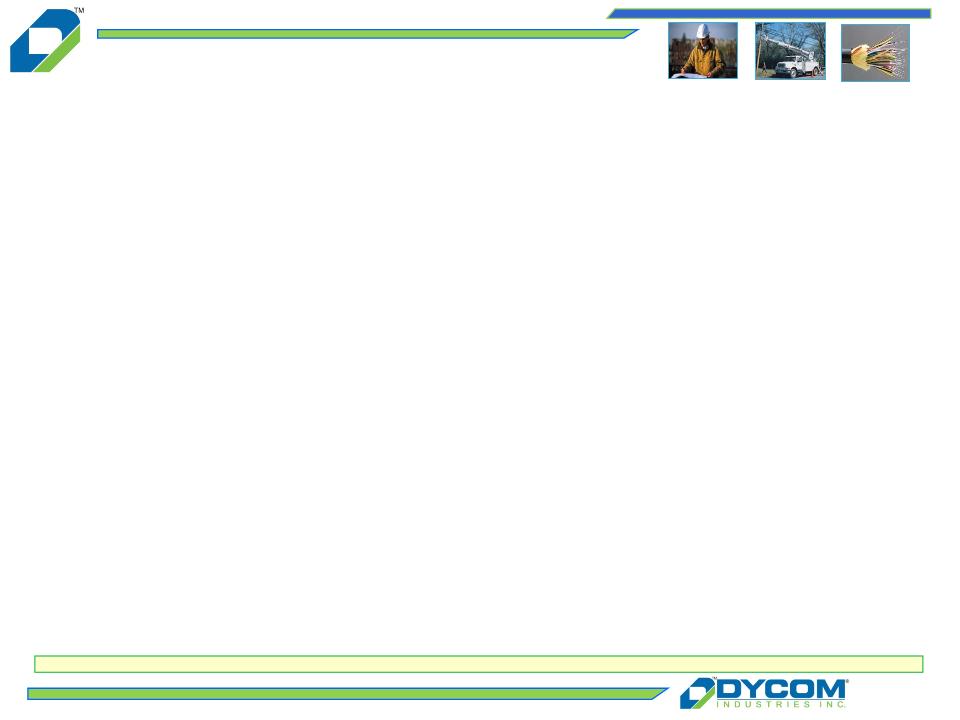
14
Growth
Strategy As Opportunities
Expand
Expand
n Build and maintain
long-term customer relationships at the local level
} Position business to
capture both recurring maintenance and new capital
spending
spending
n Empower subsidiary
management
} Build relationships
with customer contracting decision makers
} Utilize detailed
knowledge of local pricing dynamics
} Leverage
subcontractors and local trade relationships
n Deliberately select
attractive customers with profitable business
} Focus on higher
quality, long-term telecommunications industry leaders
n Selectively screen
potential acquisitions
} Healthy players that
bring long-term, established customer relationships
} Complement existing
Dycom customer footprint
} Position Company for
significant customer capital or maintenance
spending
spending
Dycom
employs a deliberate and methodical growth strategy
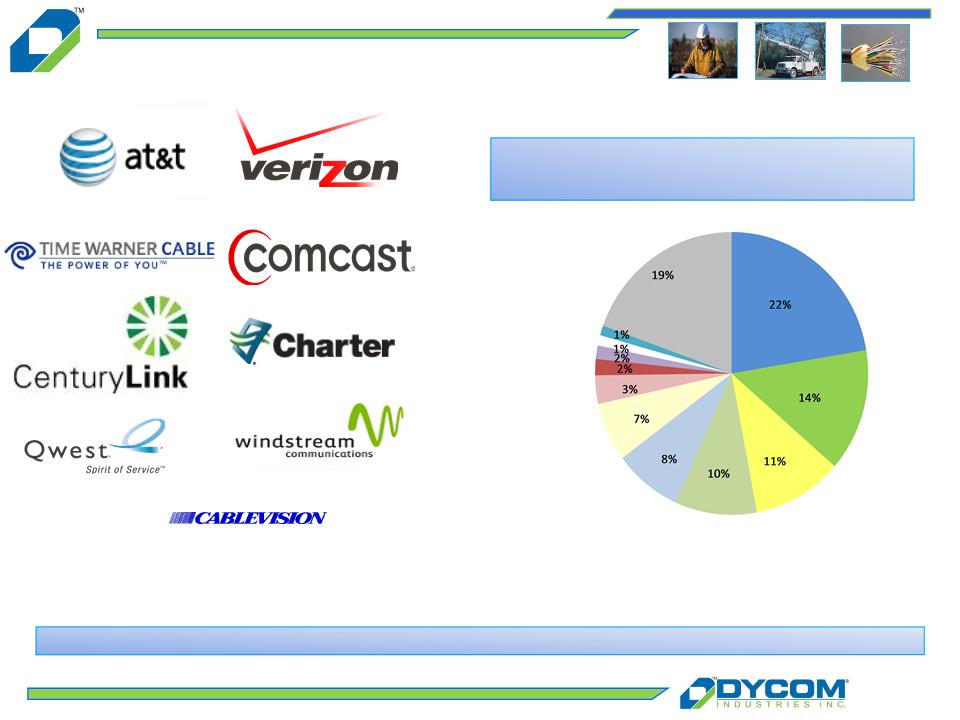
15
Blue-chip,
predominantly investment grade clients comprise the vast majority of
revenue
Well
Established Customers
Fiscal
Quarter Ended April 24, 2010
Customer
Revenue Breakdown
Other
Comcast
Charter
Cablevision
Windstream
AT&T
CenturyLink
Qwest
Verizon
Time
Warner Cable
West
Carolina Telephone
Electric
Power Board
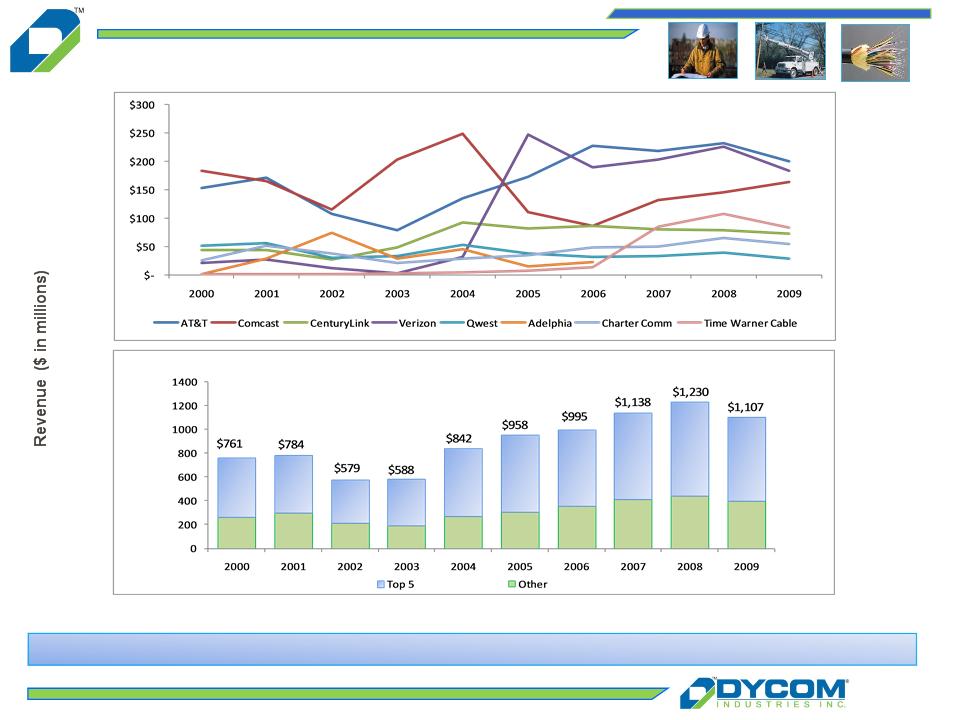
16
Customer
Rotation
Key
long-term relationships help Dycom manage the cyclical nature of telecom and
cable capex spending
For
comparison purposes, when customers have been combined through acquisition or
merger, their revenues have been combined for all periods.
65%
35%
62%
38%
63%
68%
32%
68%
32%
64%
36%
37%
63%
33%
67%
37%
64%
36%
64%
36%
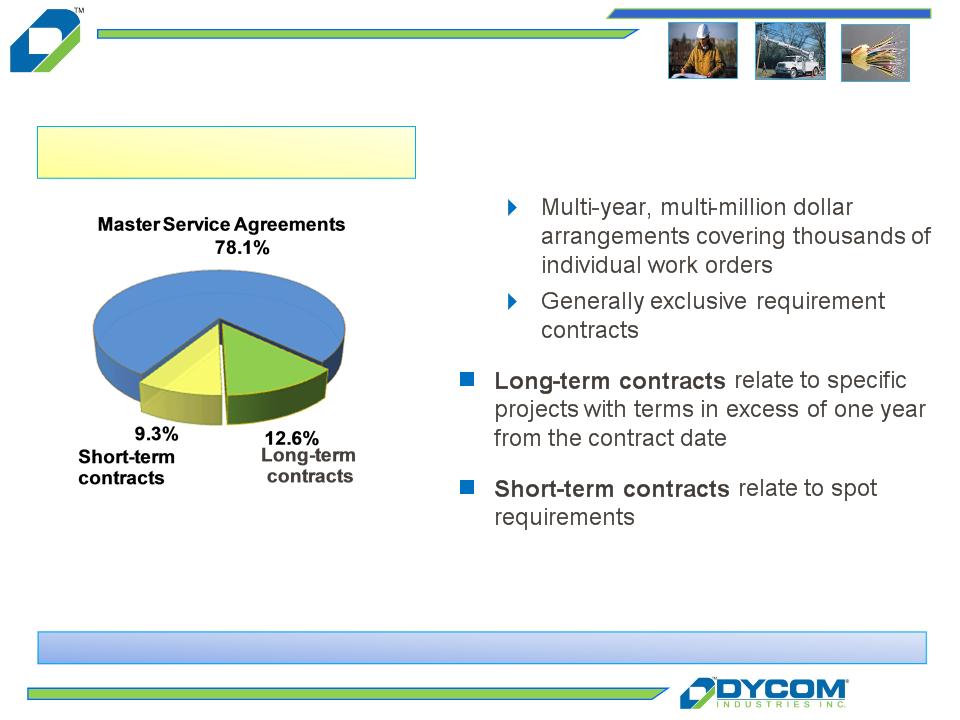
17
Dycom’s
revenue stream is primarily generated by long-term contractual
agreements
n Master
Service Agreements (MSA’s)
n Significant majority
of contracts are
based on units of delivery
based on units of delivery
Revenue
By Contract Type
Quarter Ended April 24, 2010
Quarter Ended April 24, 2010
Revenue
- Q3 Fiscal 2010
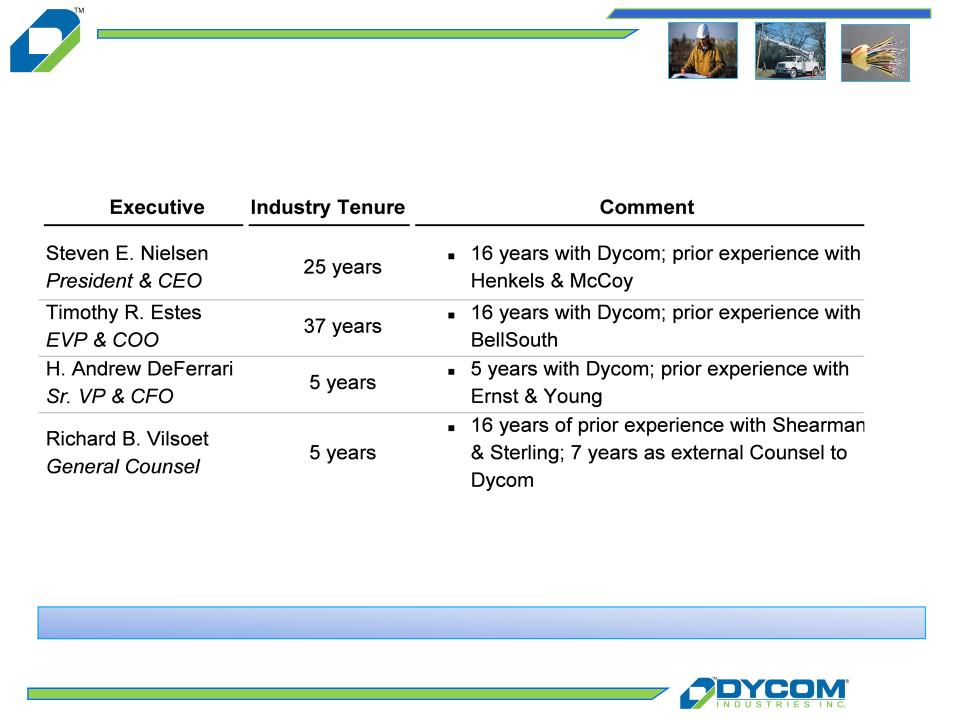
18
Senior
Management
Seasoned
management team with several decades of combined industry
experience
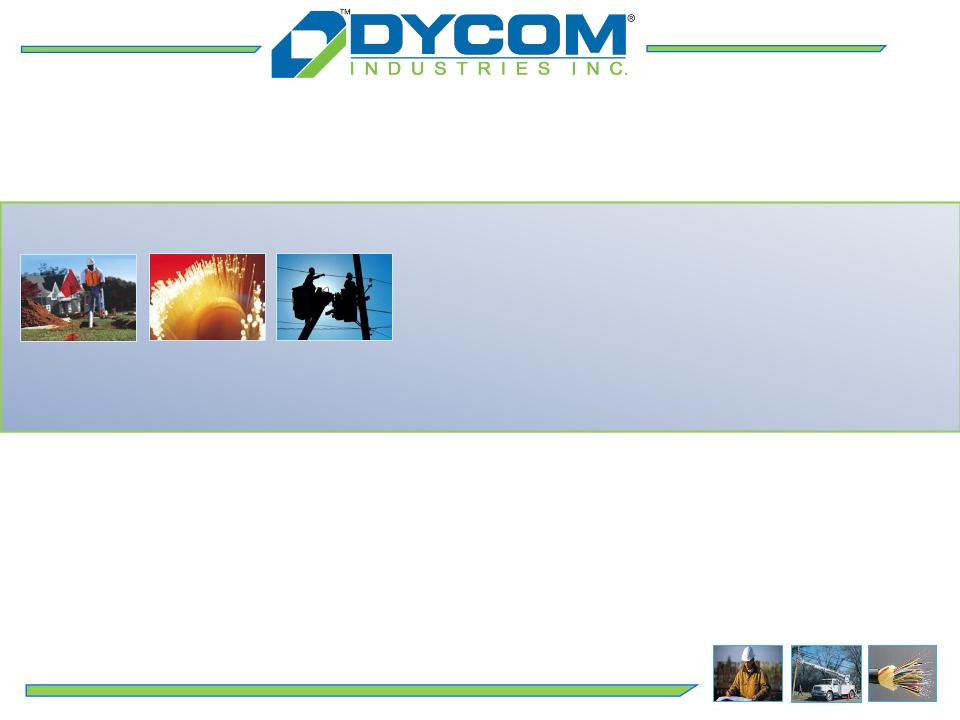
Financial
Update

20
nCentralize
activities which yield synergistic benefits
} Treasury
} Tax
} Risk
management
} Capital asset
procurement
} Information
technology resources
nDecentralize
financial operations to provide solid support
and flexibility at operating unit level
and flexibility at operating unit level
nMaintain financial
resources to support internal growth
and acquisition opportunities
and acquisition opportunities
Financial
Overview
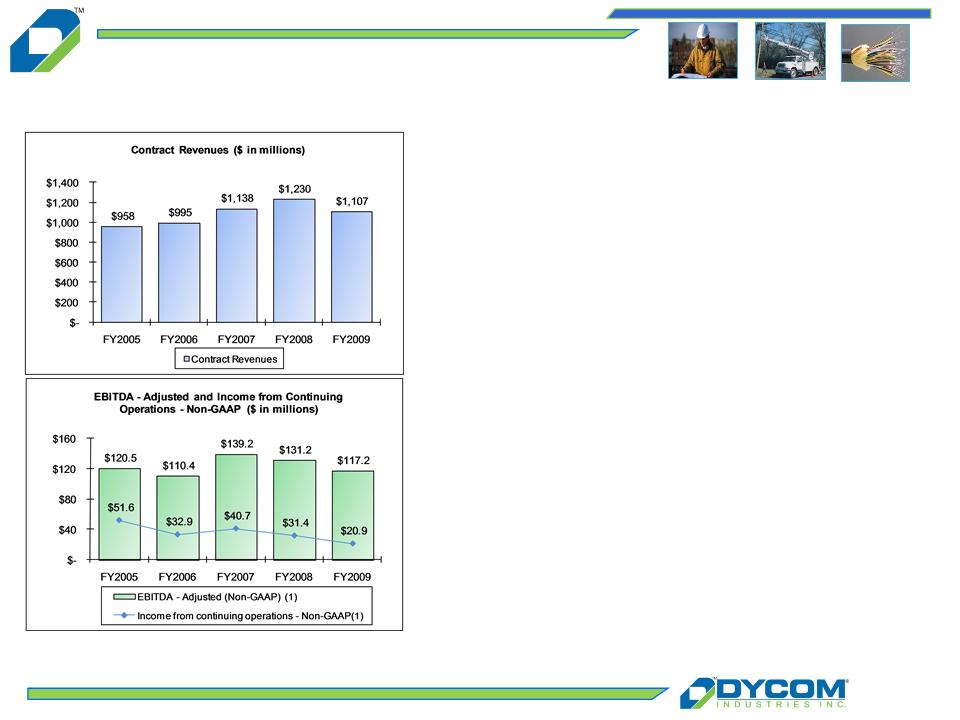
21
Fiscal
Year Results - Revenue and
Earnings
Earnings
(1) The
amounts for EBITDA - Adjusted and Income from continuing operations -Non-GAAP
are Non-GAAP financial measures adjusted to exclude certain items. See
“Regulation G Disclosure” slide for a reconciliation of Non-GAAP financial measures to GAAP financial measures.
“Regulation G Disclosure” slide for a reconciliation of Non-GAAP financial measures to GAAP financial measures.
n Annual revenue
exceeding $1.1
billion for the three most recent
fiscal years
billion for the three most recent
fiscal years
n Revenue of $707.1
million for the
nine months ended April 24, 2010
compared to $837.2 million for the
nine months ended April 25, 2009
nine months ended April 24, 2010
compared to $837.2 million for the
nine months ended April 25, 2009
n Revenue and results
impacted by
customer reductions in capital
spending plans in response to
challenging economic conditions
customer reductions in capital
spending plans in response to
challenging economic conditions
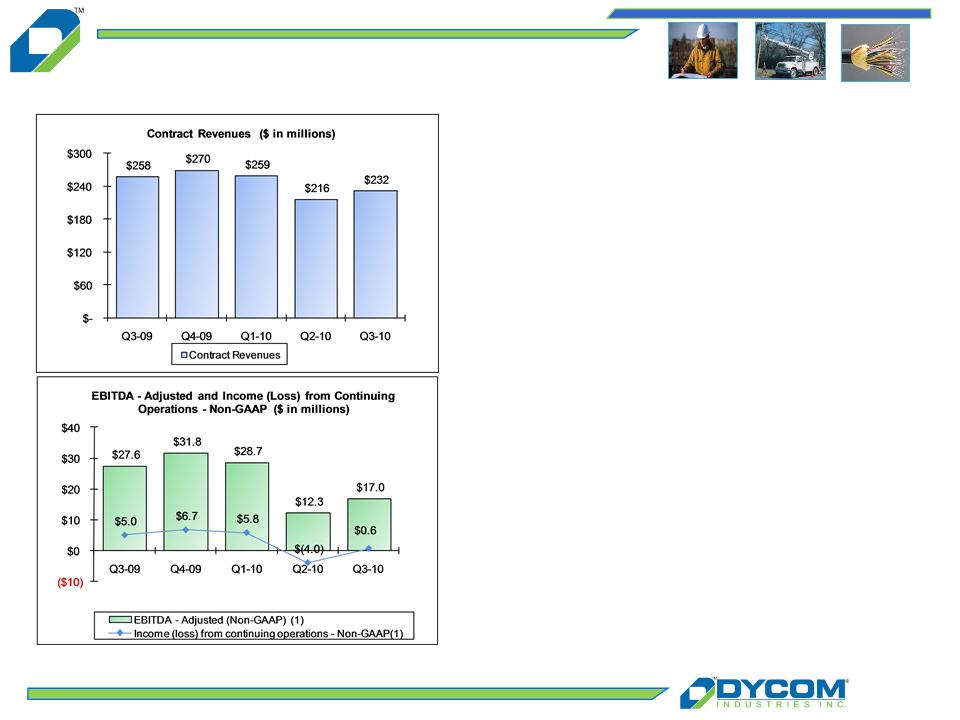
22
Quarterly
Results - Revenue and
Earnings
Earnings
n Seasonal revenue
pattern driven by
weather and available work days
weather and available work days
n Q3-10 impacted by
difficult weather
conditions; total revenue trends
beginning to improve in Q3-10
conditions; total revenue trends
beginning to improve in Q3-10
n EBITDA - Adjusted
and Income from
Continuing Operations increased
sequentially reflecting higher levels of
operations and increased productivity
Continuing Operations increased
sequentially reflecting higher levels of
operations and increased productivity
(1) The
amounts for EBITDA - Adjusted and Income (Loss) from continuing operations
-Non-GAAP are Non-GAAP financial measures adjusted to exclude
certain
items. See “Regulation G Disclosure” slide for a reconciliation of Non-GAAP financial measures to GAAP financial measures.
items. See “Regulation G Disclosure” slide for a reconciliation of Non-GAAP financial measures to GAAP financial measures.
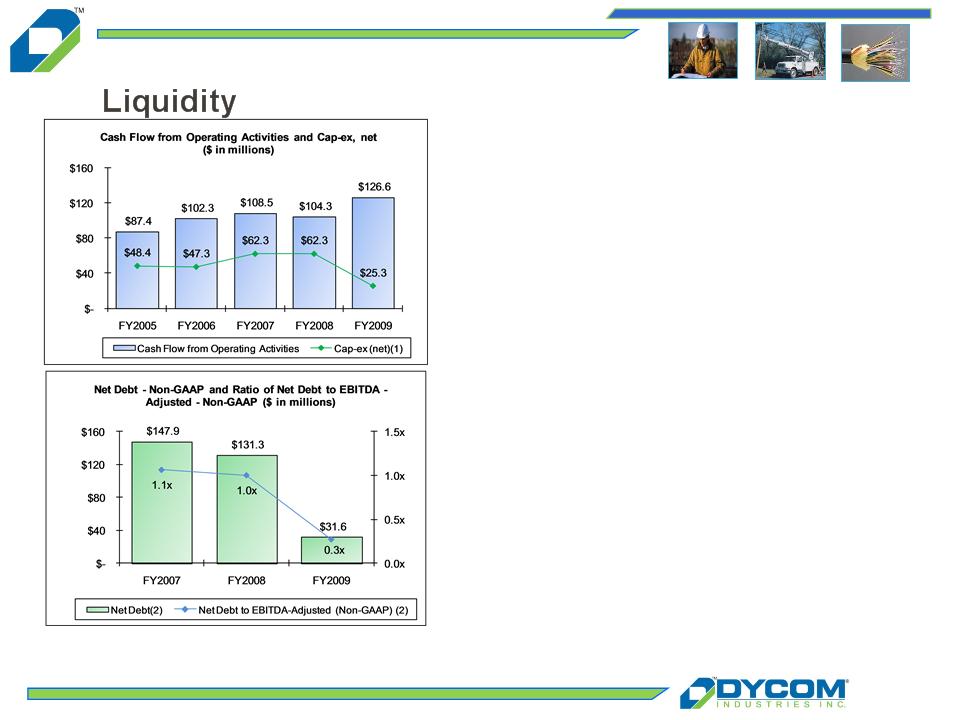
23
Fiscal
Year Results - Cash Flow and
(1)
Capital expenditures net of proceeds from the sale of assets
(2) The
amounts for EBITDA - Adjusted and Net Debt used in the calculations herein are
Non-GAAP financial measures adjusted to exclude certain items. See
“Regulation G Disclosure” slide for a reconciliation of Non-GAAP financial measures to GAAP financial measures.
“Regulation G Disclosure” slide for a reconciliation of Non-GAAP financial measures to GAAP financial measures.
n Cash flow from
operations over $100
million for the four most recent years
million for the four most recent years
n Ample cash flows to
support capital
expenditures and fund operations
expenditures and fund operations
n Long term financing
in place as of
April 24, 2010
April 24, 2010
} $135.35 million
Senior Subordinated
Notes - October 2015 maturity
Notes - October 2015 maturity
} $210 million Credit
Facility:
} September 2011
maturity
} No borrowings
outstanding
n 0.3x ratio of Net
Debt to EBITDA-Adjusted
in fiscal 2009
in fiscal 2009
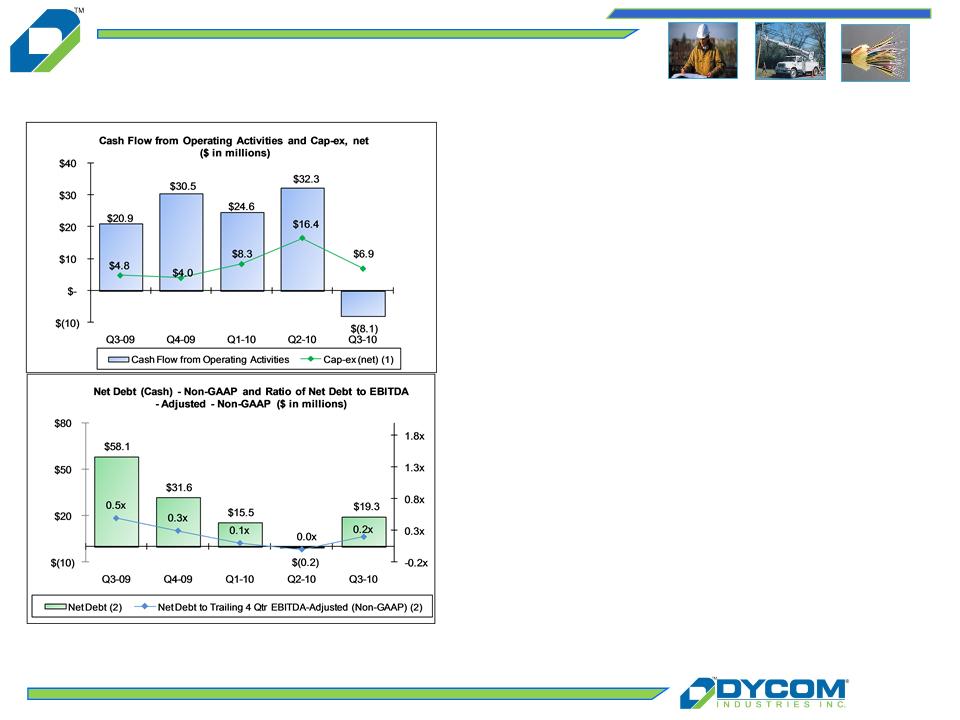
24
Quarterly
Results - Cash Flow and
Liquidity
(1)
Capital expenditures net of proceeds from the sale of assets
(2) The
amounts for EBITDA - Adjusted and Net Debt used in the calculations herein are
Non-GAAP financial measures adjusted to exclude certain items. See
“Regulation G Disclosure” slide for a reconciliation of Non-GAAP financial measures to GAAP financial measures.
“Regulation G Disclosure” slide for a reconciliation of Non-GAAP financial measures to GAAP financial measures.
n Cash flows used to
fund operations as
activity level increased during the quarter
activity level increased during the quarter
n Capital
expenditures, net of disposals at
$6.9 million
$6.9 million
n Strong financial
profile
n Ample liquidity as
of April 2010
} $116.2 million cash
and equivalents
} $131.4 million
availability under
Revolving Credit Facility
Revolving Credit Facility
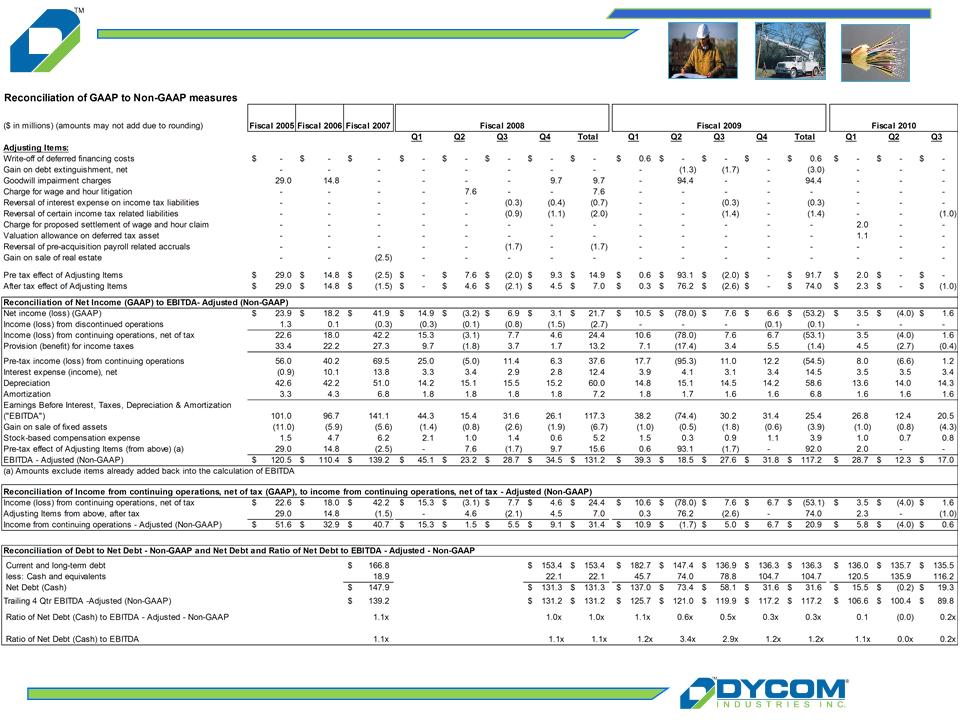
25
Regulation
G Disclosure
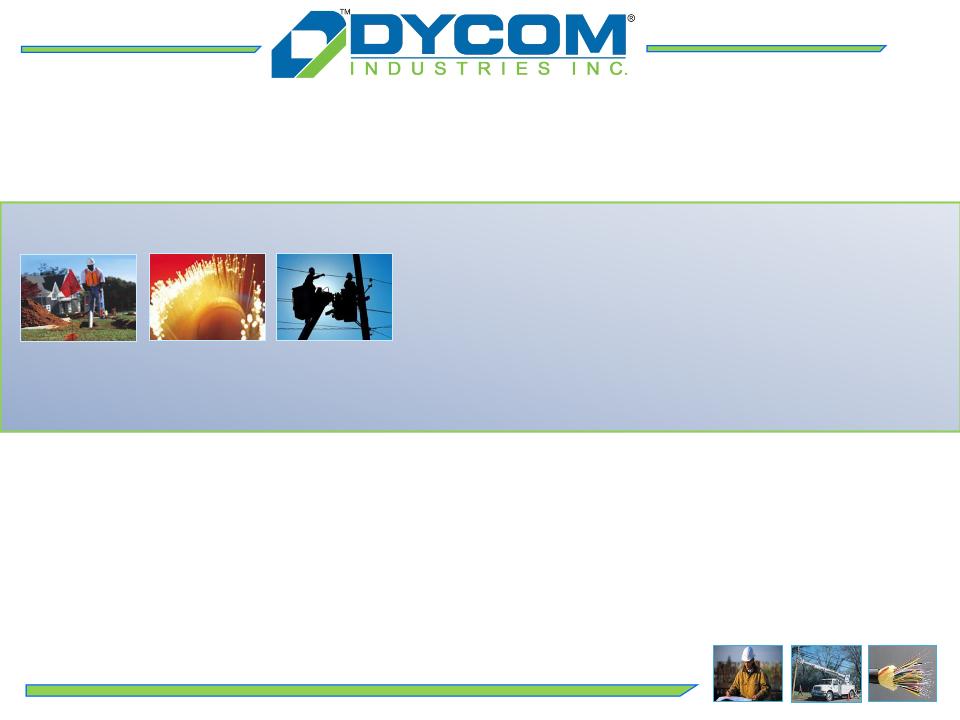
Credit
Suisse 2010 Engineering
and Construction Conference
June 3, 2010
and Construction Conference
June 3, 2010
